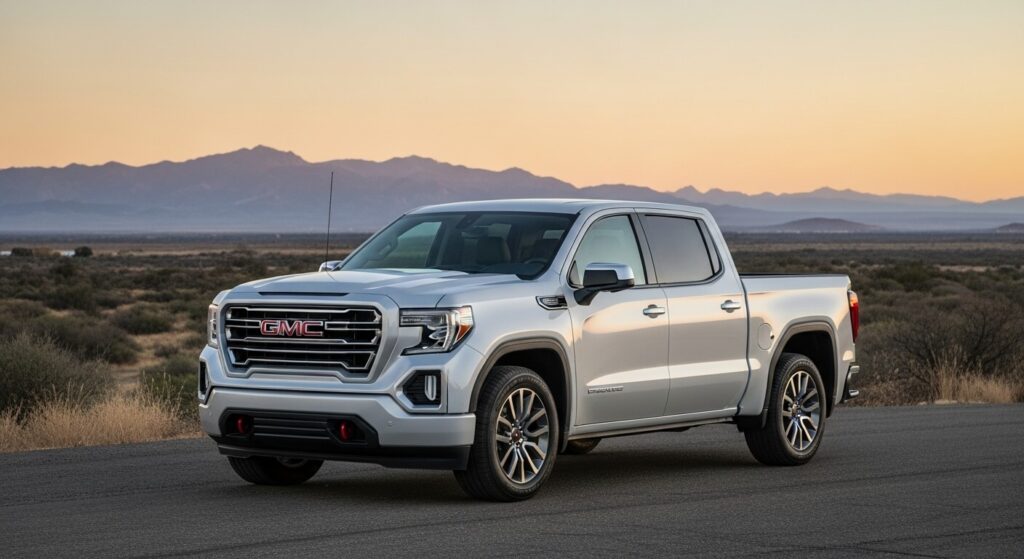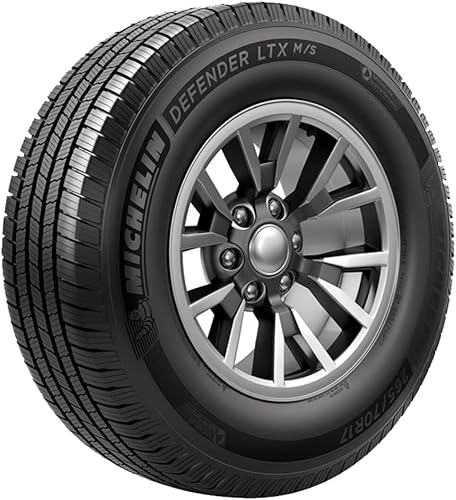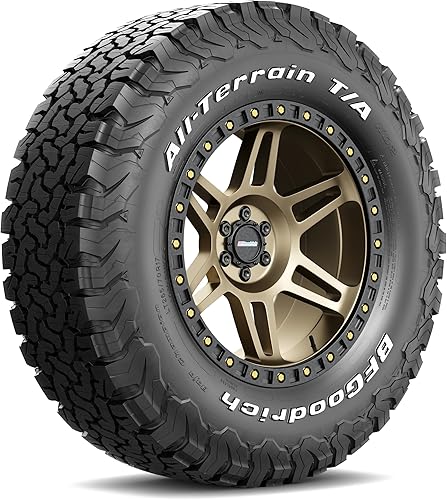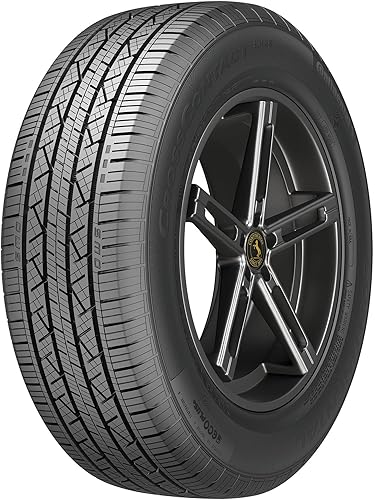Choosing the best tires for a GMC Sierra 1500 gets confusing fast, especially when you’re juggling towing needs, daily commuting, rainy-day traction, and overall ride comfort. Truck tires all promise strength and performance, but only a few actually hold up once the miles start piling on. Among the many options worth considering, the MICHELIN Defender LTX M/S All-Season Radial Tire consistently comes out ahead thanks to its long tread life, strong grip on wet pavement, and dependable load-handling that fits the Sierra 1500’s real-world demands. It’s the kind of tire that quietly does everything right without making a big fuss about it.
Best 5 Tires for GMC Sierra 1500
01. MICHELIN Defender LTX M/S All-Season Radial Tire
The MICHELIN Defender LTX M/S All-Season Radial Tire is built for real-world driving—hauling, towing, or just everyday highway miles. Designed with Michelin’s Evertread compound, it resists wear even under heavy loads, making it a go-to for trucks, SUVs, and commercial vans. Its MaxTouch Construction helps distribute forces evenly during acceleration, braking, and cornering, which means smoother performance and a longer tread life. Drivers often mention how quiet the ride feels, even after tens of thousands of miles—something that’s not easy to find in heavy-duty all-season tires.
For anyone who drives a Ford F-150, Chevy Silverado, Toyota Tacoma, or similar vehicle, this tire balances traction, longevity, and fuel efficiency better than most. It handles rain and light snow with confidence, offering a solid grip thanks to the 4-season tread design. While it’s pricier than budget brands, it’s more of a long-term investment than a quick buy—ideal for those who value durability over short-term savings.
Pros:
- Exceptional tread life with Evertread compound
- Great traction on wet and dry roads
- Quiet, comfortable ride even under load
- Suitable for trucks, SUVs, and light commercial vehicles
Cons:
- Higher price point than many competitors
- Performance in deep snow could be better
02. Cooper Discoverer S/T Maxx All-Season LT265/75R16 123/120Q Tire
The Cooper Discoverer S/T Maxx LT265/75R16 tire has a tough build that suits off-road trucks, work pickups, and heavy-duty 4×4 setups. Its chip-resistant compound, 3-ply Armor-Tek3 construction, and hybrid tread design give it a sturdy feel on gravel, rocky trails, and uneven terrain. People looking for durability in towing, hauling, and rugged all-terrain performance will find this LT tire fitting for harsh conditions where traction, load stability, and sidewall strength matter.
It also performs well as an all-season tire thanks to its deep tread blocks, wide shoulders, and solid biting edges that improve grip on wet roads, mild mud, and loose soil. The 123/120Q load rating helps pickup owners carrying tools, cargo, trailers, and camping gear. If someone needs a dependable off-road/all-terrain option for models like the Toyota Tacoma, Ford F-250, Chevy Silverado 2500, or Jeep Wrangler running LT tires, this one stays relevant in those search categories.
Pros ✅
- Strong 3-ply Armor-Tek3 construction for off-road abuse
- Good traction on gravel, dirt, mud, and wet roads
- Chip- and cut-resistant rubber compound
- High load rating suitable for towing and hauling
Cons ❌
- Can feel firm or stiff on smooth highway roads
- Slightly louder road noise compared to highway-terrain tires
- Heavier build may impact fuel efficiency a bit
03. BFGoodrich All-Terrain T/A KO2
The BFGoodrich All-Terrain T/A KO2 has long been a go-to tire for folks who take their trucks or SUVs into rough country and still want solid road manners on highways. With its thick sidewall construction, interlocking tread blocks, and aggressive all-terrain pattern, the KO2 handles gravel tracks, rocky trails, sandy stretches, and daily driving without fuss. It’s widely used on vehicles like Jeep Wrangler, Toyota Tacoma, Ford F-150, Chevy Colorado, and other off-road rigs where traction and durability matter more than looks.
If you’re aiming for tough off-road grip, long tread life, and stability on wet roads, this tire fits right into that mix. The KO2’s CoreGard technology, stone ejectors, and all-season rubber compound help it deal with sharp debris, potholes, and uneven backroads. It’s also marketed as a solid pick for overlanding setups, towing, and weekend off-roaders who don’t want to swap tires constantly.
Pros ✅
- Strong off-road traction on mud, gravel, rocks, and sand
- Reinforced sidewalls reduce puncture risk
- Good wet-road stability and braking
- Long tread life for an all-terrain tire
Cons ❌
- Can feel slightly firm or stiff on rough city roads
- Road noise may increase as the tread wears
- Pricier than many budget all-terrain options
04. Yokohama Geolandar AT G015 205/70R15 96H Tire
The Yokohama Geolandar AT G015 205/70R15 96H is the kind of all-terrain tire people pick when they want steady grip on rough backroads without giving up daily-drive comfort. Its rugged tread blocks, Endurocore construction, and all-season rubber compound help it handle rain, gravel, mild off-roading, and long highway runs. For compact SUVs and crossovers needing a dependable AT setup, this G015 keeps things stable with good wear life and solid cornering behavior. It also fits popular models that use 205/70R15 sizing, making it easier for drivers looking for reliable off-road traction without extra noise.
What stands out is how this tire manages wet braking, dirt-road traction, and snow-rated performance thanks to Yokohama’s Triple 3D sipes and Four-Pitch Tread Variation. If your daily routes mix potholes, broken pavement, and occasional trail riding, this tire usually holds up well. It’s built for year-round use and tends to stay quieter than many aggressive all-terrain options in the same class. Drivers wanting a blend of off-road ability and highway comfort often end up shortlisting it.
Pros:
- Good wet-road grip and braking
- All-terrain tread handles gravel and light trails
- Snow-rated (3PMSF) for winter conditions
- Quiet for an AT tire; stable highway manners
- Durable Endurocore construction for rough surfaces
Cons:
- Not aggressive enough for deep mud or heavy off-roading
- Slight drop in fuel efficiency due to AT tread design
05. Continental CROSS CONTACT LX25 All- Season Radial Tire
The Continental CrossContact LX25 All-Season Radial Tire is made for drivers who want steadier traction without dealing with road noise or rough steering. Its tread compound and EcoPlus tech help with longer tread life, especially for SUVs and crossovers like Honda CR-V, Toyota RAV4, Ford Escape, Subaru Outback, and similar models. The tread blocks grip well on wet pavement, which is useful if you drive in mixed weather. It also holds up nicely on highways where consistent stability matters more than aggressive off-road performance.
Here’s a quick breakdown that people usually look for:
Pros ✅
- Good wet-road traction thanks to the all-season tread compound
- Quiet ride with reduced vibration on highways
- Long tread life, suitable for daily commuters
Cons ❌
- Not meant for heavy off-roading or deep mud
- Performance dips a bit in harsh winter snow compared to real winter tires
If you need something for everyday city use, weekend highway runs, and mild weather changes, the CrossContact LX25 fits that profile well.
How to Choose The Best Tires for GMC Sierra 1500.
It always starts with that one annoying thought that refuses to leave you alone. Something like… maybe the reason your GMC Sierra 1500 feels slightly off on certain roads is because the tires are simply not the right match. People say trucks are tough, but even the toughest ones get a bit temperamental if you shove the wrong shoes on them. My uncle used to say a pickup behaves almost like a human on a bad Monday if the tires aren’t chosen well. I didn’t believe him until I tried cheap all terrains once and almost skated through a mild rain like a confused penguin. So, finding the best tires for a Sierra 1500 becomes less of a casual decision and more like picking the right boots before trekking through places your brain pretends don’t exist.
Tire Size Stuff That Feels More Important Than It Should
Every GMC Sierra 1500 rolls out with specific tire sizes stamped somewhere on the door jamb. You see it when you open the door but rarely think about it. Common factory sizes float around 255 70R17, 275 60R20 or sometimes 265 65R18 depending on trims. And then you see people online slapping 33 inch or even 35 inch tires like they’re decorating a Christmas tree. Bigger tires look cool, yeah, but your fuel economy drops by a few miles per gallon. Statistically, even a switch from stock size to 33s can reduce fuel efficiency by around 2 to 4 mpg depending on how you drive. I felt that pinch once. It stings. Unless you love donating fuel money.
But if you’re sticking close to stock sizes, everything becomes predictable. Ride comfort stays good, the truck won’t scream during acceleration, and your speedometer doesn’t start lying like some overconfident storyteller.
Highway Tires When You Only Want Peace
Sometimes you don’t want drama. Don’t want roaring treads, don’t want knobby patterns, don’t want your steering wheel vibrating like it’s playing its own music. Highway tires exist for that mood. They usually come with symmetric tread designs that look almost too neat. The rubber is harder, engineered to roll smoothly, and lasts longer when you do lots of road miles. Some tires even claim 60,000 to 70,000 mile treadwear warranties. Realistically, people usually see around 45,000 to 55,000 miles if they drive mixed routes, but still… not bad.
If you drive your Sierra mostly for family outings, city errands, office runs, and those occasional weekend drives where you just need to breathe a bit, highway tires feel like a soft pillow. They handle wet roads better than many off road tires too. And this matters more than you think, because something like 70 percent of road accidents happen on wet surfaces according to global traffic studies. So yes, simple highway tires can probably save you from moments you don’t want to re-live.
All Terrain Tires When You Think You Might Go Off Road
It happens a lot. People think they’ll go off road often, but in reality they go maybe once every three months, usually after being influenced by someone else’s Instagram stories. All terrain tires are basically a middle ground. A compromise. They look rougher than highway tires, have chunkier shoulders, and grip decently off road. But they also roll well enough on highways without screaming.
One thing to notice though, some A T tires are more aggressive than others. LT rated ones (light truck) are tougher but heavier. Heavier tires make your Sierra feel slightly sluggish. They improve towing stability though. So, if you haul furniture or tow a camper, LT tires make sense. If not, maybe P metric all terrains are enough.
Something to remember here. Tire noise. Some A T models produce that low humming noise that gets louder with age. You tolerate it at first, but after 20,000 miles you start questioning your life choices. Choosing quieter models can save your sanity.
Mud Tires Only If You Truly Mean It
Mud terrain tires look like they could climb walls or maybe eat small rocks for breakfast. They bite into loose dirt really well. But on highways they can feel harsh. Also, they wear faster. And your fuel consumption takes another hit.
But if you genuinely spend time in muddy fields, loose gravel paths, or construction-like terrain, then nothing beats a good mud tire. The Sierra 1500 has enough power and suspension tuning to make use of them. Just don’t buy them for the looks only. Unless you like replacing tires sooner than everyone else. Also some of these tires drop to half their tread in around 20,000 to 25,000 miles if used mostly on pavement.
Load Ratings And Why They Matter More Than Brand
People sneeze at load rating info like it’s boring algebra. But it decides how well your truck behaves with weight. A Sierra 1500 typically requires tires with at least a SL or XL rating for regular driving. But if you tow trailers, boats, or carry equipment often, then going for LT tires with E load rating gives extra safety.
LT tires have stronger sidewalls. When a heavy load pushes sideways during cornering, especially at highway speeds, stronger sidewalls keep everything stable. Think of it like walking with stiff boots vs soft slippers on uneven ground. Soft slippers feel comfy but wobble more.
Traction, Grip, And All That Complicated Rainy Day Behavior
Rain, snow, slush, and those icy mornings… different tires behave drastically different. The Sierra is a heavy truck. A heavier truck needs predictable traction to avoid skidding. Tires with deeper grooves and multiple sipes (small cuts on tread blocks) grip slippery surfaces better. It’s tiny details like these that decide if your truck stops in time or glides slightly forward like a mischievous ghost.
Stopping distance numbers vary but even between two similar tire types, one brand may stop 10 to 15 feet shorter in wet braking tests. That difference can be the distance between tapping someone’s bumper lightly or going home annoyed because you exchanged insurance details all afternoon.
Don’t Trust Only The Looks
Truck tire marketing is wild. Some tires look like they belong on monster trucks but perform horribly on wet roads. Others look plain but outperform everything. So never choose by looks only. A friend of mine once picked a tire because he liked the tread pattern. That pattern turned out to be loud, wore unevenly, and the truck pulled slightly left. After 8,000 miles, he regretted everything.
Stick to reviews, real testing data and driver feedback. The Sierra is popular, so there’s plenty of shared experiences out there if you dig a little.
Seasonal Tires If You Live Somewhere With Harsh Climate
If you stay in places with heavy snow, all terrains won’t fully protect you. Winter tires with the 3PMSF symbol give better grip under freezing temperatures. Rubber compounds stay softer and tread patterns kick out snow more effectively. A Sierra 1500 with proper snow tires becomes almost playful in snow. Without them, even a four wheel drive system struggles.
Summer tires on the other hand, grip like crazy in heat but become unsafe near freezing. Not many Sierra owners choose summer tires though, unless they’re doing performance setups.
Price And Brand Are Not Always The Final Answer
Some people swear by premium brands. Others say mid range brands are as good. The truth is weirdly in between. Expensive tires often give better comfort, lower noise, and consistent performance across the tread life. But some mid range ones perform 85 to 90 percent as well for cheaper.
Budget tires are tempting but risky for a truck as heavy as the Sierra. Not all, but many of them lose grip too quickly when the road gets wet. Saving money upfront sometimes costs more later.
Final Thoughts That Aren’t Really Final
Choosing the best tires for a GMC Sierra 1500 feels almost like a puzzle where the pieces keep shifting. One moment you think you need all terrains, then you realize you don’t off road enough. Or maybe you tow sometimes, so you need something stronger. And then there’s comfort, noise, braking, lifespan, fuel economy… the whole thing becomes a weird balancing act.
But once you understand your real driving behavior, the right tire sort of reveals itself. Like a quiet thought you didn’t pay attention to earlier. You start noticing which roads you actually drive, how often you tow, whether you value comfort more than looks.
If anything, treat the process like choosing something you’ll rely on daily. Because your truck won’t complain loudly when you choose the wrong tires, but you’ll feel it in little ways every single day. And those little ways eventually stack up, like a bunch of tiny reminders trying to tell you… choose wisely.






